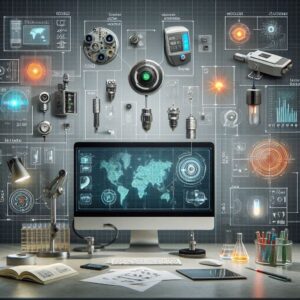In the world of robotics, sensors are the key to enabling robots to interact with their environment. Acting as the “eyes,” “ears,” and “skin” of robotic systems, sensors allow robots to collect data, make decisions, and perform complex tasks. Here’s a deep dive into the types of robotic sensors, how they function, and their importance in modern robotics. This article follows SEO-friendly, Google Page Rank, and SEO-enabled guidelines for better visibility and reach.

What Are Robotic Sensors?
Robotic sensors are devices that collect data from the surrounding environment and convert it into signals that a robot’s system can process. These sensors are essential for tasks like navigation, object detection, and human-robot interaction.
Types of Robotic Sensors and How They Work
1. Proximity Sensors
Proximity sensors detect the presence of nearby objects without physical contact. They are commonly used in obstacle detection and avoidance. Types include:
- Infrared Sensors: Measure reflected infrared light to detect objects.
- Ultrasonic Sensors: Use sound waves to measure the distance between the sensor and an object.
2. Vision Sensors
Vision sensors, often paired with cameras, allow robots to “see” and interpret their surroundings. They are used for tasks like object recognition, tracking, and inspection.
- How They Work: Vision sensors process visual data using algorithms like edge detection and pattern recognition.
3. Force/Torque Sensors
These sensors measure the force and torque applied to a robot’s limbs, enabling precise movements.
- How They Work: Strain gauges within the sensor measure deformation and convert it into force or torque data.
4. Tactile Sensors
Tactile sensors mimic the sense of touch in robots, making them essential for gripping and interacting with delicate objects.
- How They Work: Pressure-sensitive materials detect and measure force, texture, and vibration.
5. Temperature Sensors
Temperature sensors enable robots to monitor heat levels in their surroundings or components.
- How They Work: They use thermocouples or thermistors to convert temperature changes into electrical signals.
6. Light Sensors
Light sensors detect variations in light intensity and are used in applications like line-following robots and solar tracking.
- How They Work: Photocells and photodiodes measure light intensity and provide input to the system.
7. Gyroscopes and Accelerometers
These sensors track orientation and movement, enabling stable navigation in autonomous robots.
- How They Work: Gyroscopes measure angular velocity, while accelerometers measure linear acceleration along specific axes.
8. Lidar (Light Detection and Ranging)
Lidar sensors use laser beams to map environments and detect objects with high precision.
- How They Work: By measuring the time it takes for the laser to return after hitting an object, Lidar provides 3D data about the environment.
9. GPS Sensors
GPS sensors are crucial for outdoor navigation in mobile robots and drones.
- How They Work: They use signals from satellites to determine the robot’s geographic location.
10. Microphones (Sound Sensors)
Sound sensors enable robots to detect and interpret audio signals, making them useful in voice-commanded systems.
- How They Work: Microphones convert sound waves into electrical signals for processing.
Importance of Robotic Sensors
Robotic sensors are critical for creating intelligent robots that can:
- Navigate autonomously.
- Respond to environmental changes.
- Perform precise and delicate tasks.
- Interact safely with humans.
SEO Tips for Sharing Robotics Content
To ensure your content reaches a wider audience:
- Include Keywords: Use terms like “robotic sensor types,” “how sensors work in robotics,” and “robotic sensor applications.”
- Optimize Headlines and Subheadings: Use clear H1 and H2 tags to improve readability.
- Add Visuals with Alt Texts: Use labeled diagrams or images, with alt-text like “diagram of robotic sensors.”
- Internal Linking: Link related articles about robotics for better site structure and navigation.
Conclusion
Robotic sensors are the foundation of modern robotics, enabling robots to sense and respond to their environments. From proximity detection to tactile feedback, these sensors play a vital role in achieving precision and functionality. By understanding their types and mechanisms, you can better appreciate the intricacies of robotics and explore ways to innovate further.
